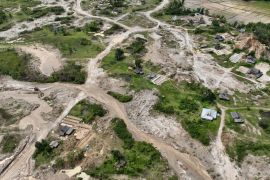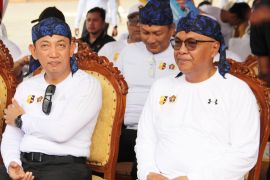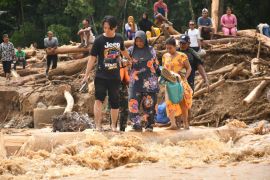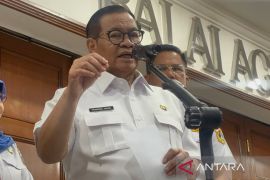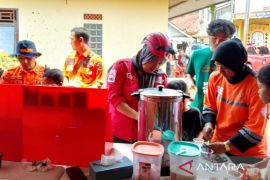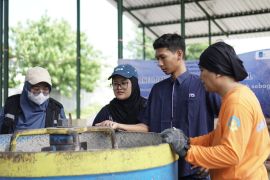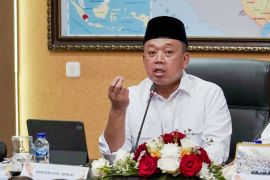Flooding in Morowali District recently destroyed four bridges and caused extensive damage to over 10 homes, and affected more than 16 thousand people in three sub-districts.
In Samarinda, East Kalimantan, floods affected 9,358 families constituting 30,580 people living in of North Samarinda, Sungai Pinang, and Samarinda Ulu sub-districts.
Triggered by torrential downpour, floods inundated seven sub-districts in North Konawe District since June 2, resulting in the Lalindu, Walasoko, and Wadambali rivers overflowing their banks. Andowia, Asera, Landawe, Langkikima, Oheo, Wiwirano, and Motui are the seven affected sub-districts.
Flooding in the worst-affected North Konawe reportedly caused financial losses amounting to Rp674.8 billion and led to the displacement of 9,609 people and affected 18765 others, Ruksamin, the North Kunawe district head, stated.
The flooding destroyed four bridges and 370 homes along with inundating four other bridges, 1,962 homes, five mosques, 14 elementary schools, five junior high schools, a senior high school, 17 kindergartens, three traditional markets, and at least four community health centers, as well Trans-Sulawesi highway.
Floods also submerged 970.3 hectares of rice fields, 83.5 hectares of corn fields, 11 hectares of other commodity fields, and 727.4 hectares of ponds.
The local authorities have deployed personnel -- local, military, and police officers -- to facilitate the evacuation of flood victims.
Relief assistance in the form of thousands of boxes of instant noodles and mineral water, more than 42 thousand kilograms of rice, and at least 1,563 sacks of clothing was distributed.
Commission VIII of the House of Representatives (DPR) disbursed financial assistance of over Rp4.2 billion for flood victims on June 23, 2019.
The Public Works and Public Housing (PUPR) Ministry has made sustained efforts to restore access to the villages cut off by the flooding in North Konawe District.
Access to the road connecting North Konawe District to Morowali District in Central Sulawesi was reopened on June 17 after the ministry conducted temporary repair of the Asera Bridge, Yohanis Tulak Todingrara, head of the Kendari road construction office (Kendari BPJN), noted in a statement.
The repair was conducted by installing a 30-meter-long Beiley bridge that can take a maximum load of eight tons.
Todingrara remarked that Rahabangga Bridge, located in Uepai Village, Konawe District, was also repaired. The flood had damaged the bridge, thereby resulting in access being severed to the road connecting Konawe and East Kolaka District, part of the Trans Sulawesi highway.
The ministry has also repaired the 50.2-meter-long Woimendaa Bridge over the Trans Sulawesi Highway in Kolaka. The Baeni II Bridge, located in Wawatobi-Pohara, submerged by floodwaters, was reopened, as floodwaters subsided.
The Southeast Sulawesi flooding was believed to have been worsened by environmental damage following forest area conversion into plantation and mining areas.
Indonesia's Disaster Mitigation Agency (BNPB) has reiterated the need for forest restoration and rehabilitation in South Sulawesi to recover the lost functions and benefits.
The BNPB chief, accompanied by a delegation of the DPR's Commission VIII, led by legislator Ali Tahir Parasong, paid a visit to flood-affected Southeast Sulawesi recently.
"Water is a source of life, but it will serve no purpose if it cannot be absorbed into the Earth. The flood disaster is a glaring reality that can serve as a lesson for us all," Lt General Doni Monardo, the BNPB chief, stated here on June 24, 2019, while visiting an emergency shelter of flood victims in the province.
He called for restoring the forest's functions to improve its water-absorbing capabilities, so it would help avert flooding.
Monardo suggested that the provincial government should form a team constituting environmentalists, geologists, and other stakeholders to unearth the reasons behind flooding and landslides that struck Konawe and to come up with solutions to prevent flooding in future.
The team must also put forth suggestions concerning long-term solutions to stop environmental degradation owing to the conversion of forests into plantation and mining areas, he reiterated.
Earlier, Police Chief General Tito Karnavian reiterated the significance of conducting a study to unearth the reason behind the flooding.
"We need to find out what has caused this flash flood, since several districts are affected, so this has, by default, come under the jurisdiction of the provincial authorities aided by the central government," Karnavian, who was accompanied by Indonesia’s Defense Forces (TNI) Commander Marshal Hadi Tjahjanto, remarked while reviewing the handling of floods in North Konawe on June 22, 2019.
He highlighted the importance of getting universities involved in studying environmental conditions to expose the root cause of the problem of flooding in North Konawe.
Flooding occurred most likely due to a decline in the environment's carrying capacity, taking into account the fact that the vast Southeast Sulawesi region had drawn investment in various fields, including mining and plantation.
Reporter: Fardah
Editor: Eliswan Azly
Copyright © ANTARA 2019


